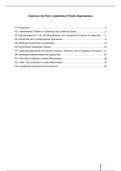College aantekeningen
Lecture notes of Deep Learning
- Instelling
- Tilburg University (UVT)
These are the lecture notes taken from the course Deep Learning given by Dr Görkem Saygili at Tilburg University in the year 2024/2025 SM1. It contains the theoretical aspects of the course.
[Meer zien]





